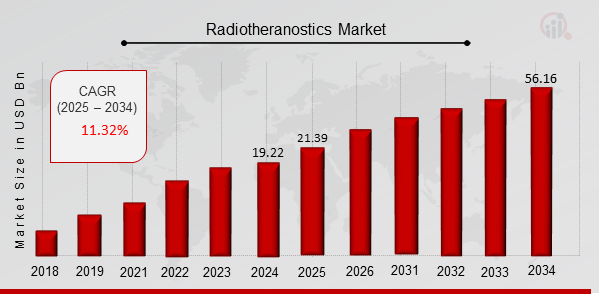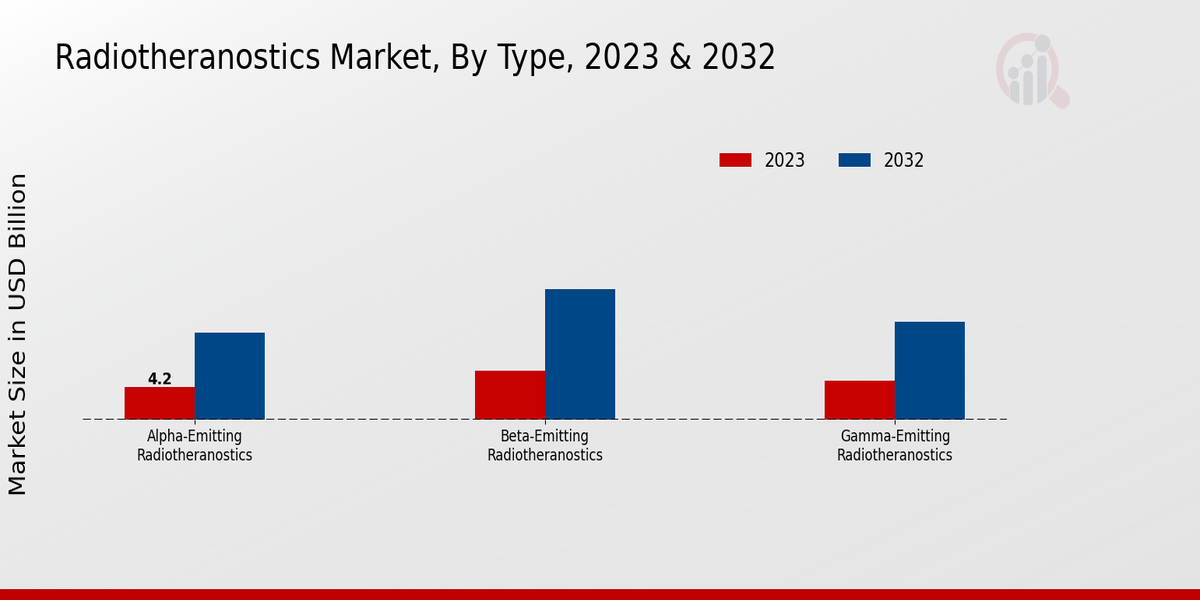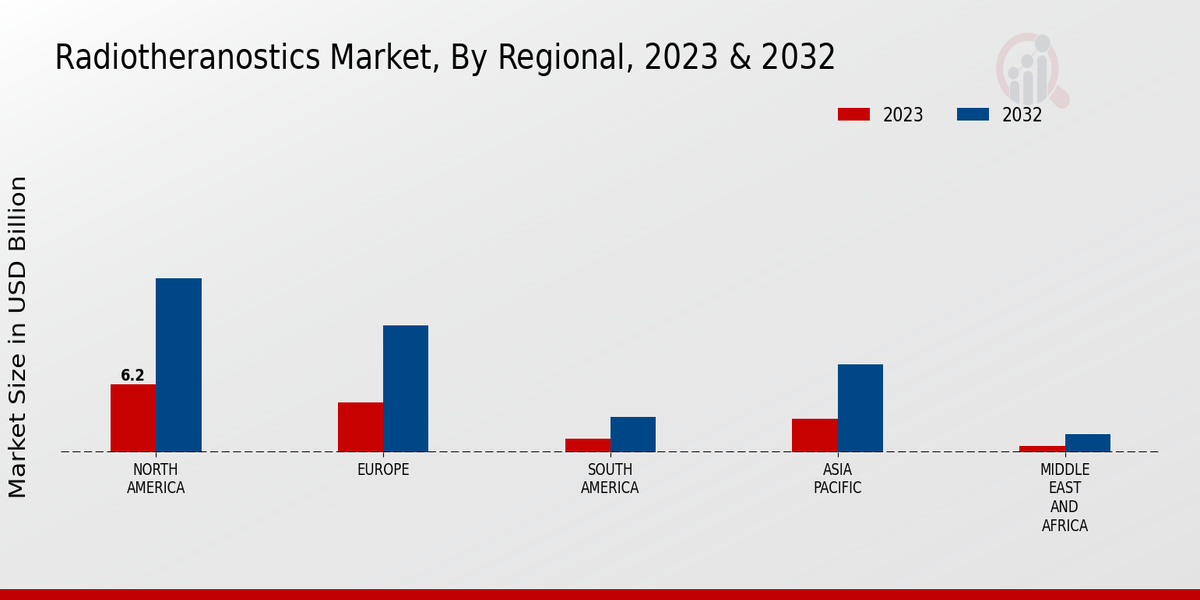Radiotheranostics Market Overview
As per MRFR analysis, the Radiotheranostics Market Size was estimated at 19.22 (USD Billion) in 2024. The Radiotheranostics Market Industry is expected to grow from 21.39 (USD Billion) in 2025 to 56.16 (USD Billion) till 2034, at a CAGR (growth rate) is expected to be around 11.32% during the forecast period (2025 - 2034).
Key Radiotheranostics Market Trends Highlighted
The Radiotheranostics Market is witnessing a surge in demand, driven by advancements in targeted therapies and the need for personalized treatment options. Key market drivers include the increasing prevalence of cancer and the growing adoption of theranostic approaches that combine diagnostic and therapeutic modalities.
Opportunities abound in the Radiotheranostics Market, such as the development of novel radiopharmaceuticals and innovative delivery systems. The integration of artificial intelligence (AI) into theranostic applications is also expected to create new avenues for growth.
Recent trends in the Radiotheranostics Market include the rise of theranostic combinations for specific cancer types, the development of theranostic platforms for personalized medicine, and the increasing use of theranostics in clinical trials.

Source: Primary Research, Secondary Research, MRFR Database and Analyst Review
Radiotheranostics Market Drivers
Rising Prevalence of Cancer
The increasing incidence of cancer worldwide is a major driver of the radiotheranostics market. Cancer is a leading cause of death globally, and the number of new cases is expected to rise in the coming years. This is due to a number of factors, including population growth, aging, and changes in lifestyle. As the number of cancer patients increases, so too does the demand for effective treatments. Radiotheranostics offers a targeted and effective way to treat cancer, and it is becoming increasingly popular as a treatment option.
The rising prevalence of cancer is expected to continue to drive the growth of the radiotheranostics market in the coming years.
Technological Advancements
The radiotheranostics market is also being driven by technological advancements. In recent years, there have been significant advances in the development of radiopharmaceuticals and imaging techniques. These advances have made it possible to develop more targeted and effective radiotheranostics treatments. For example, the development of new radiopharmaceuticals that can target specific cancer cells has made it possible to deliver higher doses of radiation to the tumor while minimizing damage to healthy tissue.
Additionally, the development of new imaging techniques has made it possible to more accurately track the delivery of radiation to the tumor. These technological advancements are expected to continue to drive the growth of the radiotheranostics market in the coming years.
Government Support
Government support is another factor contributing to the growth of the radiotheranostics market. Radiotheranostics’ potential to enhance cancer care is being recognized by governments globally and is resulting in their support. This support comes in several different forms, such as research and development funding, radiotheranostics treatment reimbursement, and specialized cancer centers. It is likely that government support will continue to impact the market positively over the next few years.
Radiotheranostics Market Segment Insights
Radiotheranostics Market Type Insights
The segment was pivotal, encompassing various radiotheranostic technologies. Among the categories, Beta-Emitting Radiotheranostics held a significant position, with a market valuation of 6.3 USD Billion in 2023, indicating its influence in the industry for disease treatment and diagnosis. This type was particularly vital due to its ability to provide targeted therapy options, enhancing therapeutic outcomes for patients.
Alpha-Emitting Radiotheranostics, valued at 4.2 USD Billion in 2023, also played a crucial role in the treatment of specific cancers, demonstrating its importance through continuous advancements and applications in targeted radioimmunotherapy.
Furthermore, the Gamma-Emitting Radiotheranostics segment contributed with a valuation of 5.0 USD Billion in the same year, serving a critical role in imaging and aiding in the precise identification of malignant cells, which is essential for effective treatment planning. The market growth within these types is driven by the rising prevalence of cancer, demand for precision medicine, and advancements in radiopharmaceuticals, which enable customized treatment protocols.
Additionally, ongoing research into novel compounds is likely to enhance the efficacy of these therapies. However, challenges such as the regulatory environment and supply chain complexities may impact growth.
Nonetheless, the opportunity to innovate and expand applications of radiotheranostics remains prominent, ensuring sustained interest and investment in this dynamic market.
As such, the Global Radiotheranostics Market segmentation clearly reflects the critical roles of Alpha-Emitting, Beta-Emitting, and Gamma-Emitting types, each contributing uniquely to the overall advancement of radiotherapy and diagnosis, with trends indicating an evolving healthcare landscape that increasingly values targeted treatments and personalized medicine.

Source: Primary Research, Secondary Research, MRFR Database and Analyst Review
Radiotheranostics Market Treatment Approach Insights
The Global Radiotheranostics Market in the Treatment Approach segment is poised for significant growth, reflecting the evolving landscape of targeted cancer therapies. In this segment, Targeted Alpha Therapy (TAT) is gaining prominence for its ability to deliver highly localized radiation, minimizing damage to surrounding healthy tissues while effectively targeting malignant cells.
Similarly, Radioimmunotherapy (RIT) combines the principles of immunotherapy with radiation, offering innovative treatment options that harness the immune system. Furthermore, Peptide Receptor Radionuclide Therapy (PRRT) plays a crucial role in managing neuroendocrine tumors, showcasing its effectiveness with a targeted approach. Together, these methodologies form a critical part of the market's segmentation, catering to specific patient needs and enhancing treatment outcomes, ultimately indicating a robust trajectory for the Global Radiotheranostics Market data and statistics.
The increasing demand for personalized treatment options, along with expanding clinical indications, creates numerous opportunities for growth within this sector, aligning with the overall market trend toward advanced therapeutics.
Radiotheranostics Market Application Insights
The segment encompasses a range of applications including Cancer, Cardiovascular Disease, and Inflammatory Diseases, contributing significantly to market dynamics. Cancer applications dominate the landscape due to the increasing prevalence of various cancer types and the rising demand for targeted therapies, making it a focal point for technological advancements.
Cardiovascular Disease applications also hold substantial importance, driven by the growing incidence of heart-related conditions globally. Inflammatory Diseases, while smaller in comparison, represent an area of emerging opportunities as advancements in diagnostics and treatment methods continue to evolve.
The Global Radiotheranostics Market statistics reveal an underlying trend towards personalized medicine, where tailored therapies are expected to improve patient outcomes. Key growth drivers include technological innovations, the surge in healthcare expenditure, and the increasing focus on early diagnosis.
However, the market also faces challenges such as regulatory hurdles and the high cost of therapies, which could impact adoption rates. Nevertheless, the overall application segment presents a promising outlook for stakeholders invested in the Global Radiotheranostics Market.
Radiotheranostics Market Delivery Method Insights
The Global Radiotheranostics Market is experiencing robust growth, particularly in the Delivery Method segment. This segment encompasses various techniques, with Intravenous, Intra-Arterial, and Intraperitoneal methods playing pivotal roles in enhancing delivery efficiency.
Intravenous delivery is a leading choice due to its ease of administration and rapid therapeutic effect, while Intra-arterial methods provide targeted treatment directly to tumor sites, thus improving efficacy and minimizing systemic exposure.
Intraperitoneal delivery, although less common, is gaining traction for treating localized cancers and offers the advantage of direct access to peritoneal tumors. The ongoing advances in technology and the growing prevalence of cancer globally are significant drivers of market growth, creating opportunities for enhanced drug delivery and improved patient outcomes.
However, challenges such as high costs and regulatory hurdles remain present. Overall, the Global Radiotheranostics Market data suggest a dynamic landscape, and the delivery methods will continue to evolve, contributing to the overall market statistics as it expands.
Radiotheranostics Market Regional Insights
North America dominated this market with a valuation of 6.2 USD Billion, projected to reach 15.8 USD Billion by 2032, representing the majority holding due to advanced healthcare infrastructure and strong research initiatives. Europe followed closely, valued at 4.5 USD Billion in 2023 and expected to grow to 11.5 USD Billion, fueled by innovative medical technologies and increasing patient awareness.
The Asia Pacific region, valued at 3.0 USD Billion in 2023 and projected to reach 8.0 USD Billion by 2032, is significant for its rapidly expanding healthcare services and large patient population. South America and the Middle East and Africa represented smaller but notable segments, valued at 1.2 USD Billion and 0.6 USD Billion, respectively, highlighting opportunities for growth in emerging markets.
The growth in these regions is driven by rising investments in healthcare, advancements in radiotheranostic therapies, and an increasing prevalence of cancer, which collectively contribute to the overall Global Radiotheranostics Market revenue and its future growth potential.

Source: Primary Research, Secondary Research, MRFR Database and Analyst Review
Radiotheranostics Market Key Players And Competitive Insights
Major players in Radiotheranostics Market are constantly striving to gain competitive edge by introducing innovative products and expanding their geographical reach. Leading Radiotheranostics Market players are focusing on strategic collaborations and partnerships to enhance their market presence and drive Radiotheranostics Market development.
The Radiotheranostics Market Competitive Landscape is characterized by intense competition among established players and emerging entrants. A leading player in the Radiotheranostics Market, Novartis, has a strong focus on research and development, and has invested heavily in expanding its product portfolio.
The company's commitment to innovation has resulted in the development of several novel radiotheranostics, including Lutathera and Pluvicto. Novartis has also pursued strategic acquisitions to strengthen its position in the market, such as the acquisition of Endocyte in 2021. A key competitor in the Radiotheranostics Market, Bayer, has a diverse product portfolio that includes Xofigo and Nubeqa. The company has a strong presence in Europe, and North America is expanding its reach into emerging markets.
Bayer is committed to personalized medicine, and is investing in research to develop targeted radiotheranostics for specific patient populations. The company's recent acquisition of Blue Earth Diagnostics will further enhance its capabilities in the field of precision medicine.
Key Companies in the Radiotheranostics Market Include
- Advanced Accelerator Applications
- Lantheus Holdings
- POINT Biopharma
- Precision Biosciences
- Redpoint Biotherapeutic
- Ellipsis Pharma
- Actinium Pharmaceuticals
- ImmunoMet Therapeutics
- Telix Pharmaceuticals
- GE Healthcare
- SIR Tex Renewables
- Bayer
- Novartis
- Theratechnologies
- Curium
Radiotheranostics Market Developments
The Radiotheranostics Market is anticipated to grow significantly over the forecast period, driven by factors such as the rising prevalence of cancer and increasing demand for personalized and targeted therapies. The market is expected to witness several key developments and trends in the coming years.
One notable trend is the growing adoption of theranostic radiopharmaceuticals, which combine diagnostic and therapeutic capabilities. These radiopharmaceuticals allow for more precise and effective treatment planning, leading to improved patient outcomes. Additionally, advancements in radiopharmaceutical production and delivery technologies are enhancing the safety and efficacy of radiotheranostics.
The market is also witnessing increased investment in research and development activities by pharmaceutical companies and biotechnology startups. This is leading to the development of novel radiotheranostic agents with improved targeting capabilities and reduced side effects. Partnerships and collaborations between industry players are also becoming increasingly common, fostering innovation and accelerating the development of new products.
Radiotheranostics Market Segmentation Insights
Radiotheranostics Market Type Outlook
- Alpha-Emitting Radiotheranostics
- Beta-Emitting Radiotheranostics
- Gamma-Emitting Radiotheranostics
Radiotheranostics Market Treatment Approach Outlook
- Targeted Alpha Therapy (TAT)
- Radioimmunotherapy (RIT)
- Peptide Receptor Radionuclide Therapy (PRRT)
Radiotheranostics Market Application Outlook
- Cancer
- Cardiovascular Disease
- Inflammatory Diseases
Radiotheranostics Market Delivery Method Outlook
- Intravenous
- Intra-Arterial
- Intraperitoneal
Radiotheranostics Market Regional Outlook
- North America
- Europe
- South America
- Asia Pacific
- Middle East and Africa
|
Report Attribute/Metric
|
Details
|
|
Market Size 2024
|
19.22 (USD Billion)
|
|
Market Size 2025
|
21.39 (USD Billion)
|
|
Market Size 2034
|
56.16 (USD Billion)
|
|
Compound Annual Growth Rate (CAGR)
|
11.32 % (2025 - 2034)
|
|
Report Coverage
|
Revenue Forecast, Competitive Landscape, Growth Factors, and Trends
|
|
Base Year
|
2024
|
|
Market Forecast Period
|
2025 - 2034
|
|
Historical Data
|
2020 - 2024
|
|
Market Forecast Units
|
USD Billion
|
|
Key Companies Profiled
|
Advanced Accelerator Applications ,Lantheus Holdings ,POINT Biopharma ,Precision Biosciences ,Redpoint Biotherapeutic ,Ellipsis Pharma ,Actinium Pharmaceuticals ,ImmunoMet Therapeutics ,Telix Pharmaceuticals ,GE Healthcare ,SIR Tex Renewables ,Bayer ,Novartis ,Theratechnologies ,Curium
|
|
Segments Covered
|
Type ,Treatment Approach ,Application ,Delivery Method ,Regional
|
|
Key Market Opportunities
|
Precision Personalized Medicine
Growing Cancer Prevalence
Advancement in Radiopharmaceutical Development
|
|
Key Market Dynamics
|
Rise in cancer prevalence
Increasing adoption of personalized medicine
Technological advancements in radiotheranostics
Growing government and industry funding
Expanding indications for radiotheranostics in various cancers
|
|
Countries Covered
|
North America, Europe, APAC, South America, MEA
|
Frequently Asked Questions (FAQ) :
The Global Radiotheranostics Market is projected to be valued at 56.16 USD Billion by the year 2034.
The anticipated compound annual growth rate (CAGR) for the Global Radiotheranostics Market from 2025 to 2034 is 11.3%.
North America is expected to dominate the Global Radiotheranostics Market with a projected value of 15.8 USD Billion in 2032.
The market size for Beta-Emitting Radiotheranostics is expected to reach 16.8 USD Billion by 2032.
Major players in the Global Radiotheranostics Market include Advanced Accelerator Applications, Lantheus Holdings, POINT Biopharma, and GE Healthcare among others.
The projected market size for Alpha-Emitting Radiotheranostics is anticipated to be 11.2 USD Billion in 2032.
The Asia Pacific region is expected to grow to a market value of 8.0 USD Billion by 2032, indicating significant growth opportunities.
The Gamma-Emitting Radiotheranostics market is forecasted to reach a value of 12.6 USD Billion in 2032.
Key growth drivers for the Global Radiotheranostics Market include advancements in targeted therapies and increased adoption of personalized medicine.
In 2023, the North American market for Radiotheranostics was valued at 6.2 USD Billion.

















